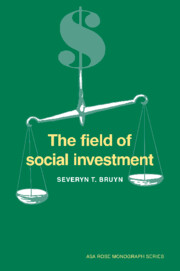Book contents
- Frontmatter
- Contents
- Preface
- Part I The idea of social investment
- Part II Social criteria and research
- 4 Social investment in business corporations
- 5 Social investment in industry: a new social policy
- 6 Social research on industrial policy
- 7 Investment in community development
- Part III Global social investment
- Epilogue: Social investment as a self-correcting movement in the market system
- Notes
- Bibliography
- Name index
- Subject index
- Title in the Series
4 - Social investment in business corporations
Published online by Cambridge University Press: 19 January 2010
- Frontmatter
- Contents
- Preface
- Part I The idea of social investment
- Part II Social criteria and research
- 4 Social investment in business corporations
- 5 Social investment in industry: a new social policy
- 6 Social research on industrial policy
- 7 Investment in community development
- Part III Global social investment
- Epilogue: Social investment as a self-correcting movement in the market system
- Notes
- Bibliography
- Name index
- Subject index
- Title in the Series
Summary
Having set a general framework that explains the development of a social (nonstatist) economy, we can now look at the norms guiding investors at the corporate level, and translate the general concept of social development into a more specific framework of normative investment policy.
We begin with a review of research on corporate goals to assist the social analysts interested in finding a synthesis of social and economic goals. The latter criteria (or norms) point to the creative edge of organizational development in corporate life, an edge represented by democratic experiments in business enterprise. We conclude by discussing some of the problems of corporate development and community relations that democratically oriented companies share with conventional ones. We point to some of the dangers and pitfalls of the investment process.
Our purpose is to look for a connection between the practice of social investment and substantiating empirical evidence. Social investors are increasingly interested in how the results of scientific research can become a basic part of the guidelines for decision making.
Research on corporate goals
Organizational researchers have shown that social and economic factors in corporate goals are closely intertwined. The classical interpretation of business behavior declared only one goal: profit maximization. And it assumed that there were only single owners who managed the firm for a profit. This classical interpretation is now seen as inapplicable to the whole business economy; it is better restricted to certain sectors. In the main, business corporations can best be understood when viewed as having many goals and many stakeholders who together define the goals.
- Type
- Chapter
- Information
- The Field of Social Investment , pp. 71 - 90Publisher: Cambridge University PressPrint publication year: 1987

